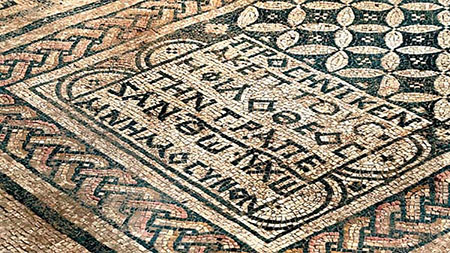by WorldTribune Staff, April 17, 2022
The excavation site of a church believed to have been built in the third-century, which may be the first known such Christian structure in the world, will be open to the public starting this summer, Israeli officials say.
The church was first discovered in 2004 beneath the Meggido prison, which is about 20 minutes from Nazareth, The Times of Israel reported.

The church also contains the first known mosaic dedicated to Jesus. A Greek inscription “to the God Jesus Christ” was found in 2004 at the site.
The Megiddo Regional Council and the Israeli Prison Service met with the Israeli Antiquities Authority last month and decided to relocate the prison, according to officials.
“Would you believe that the first church in the world is inside a prison?!” the Israeli Prison Service posted on Facebook, as translated, in an announcement about the prison’s move.
The current prison will be moved so archaeologists can excavate the site further, and the church and its mosaic will be made into a tourist destination.
The mosaic is the first known time that Jesus was named as a god in Israel. Other mosaics were also found, including patterns and a medallion of two fish. The Ichthys, or fish, was a secret early Christian symbol used to recognize churches.
A total of three inscriptions in Greek were found in the church and deciphered by Israeli Antiquities Authority’s Leah De Signi, the agency’s website reported.
One says that a Roman army officer donated the money to build the mosaic. Another memorializes four women. The final mosaic faces west and features the name of a woman who dedicated an altar there to Jesus.
The archaeological evidence shows that Roman army officers were part of the early Christian community in the century before Emperor Constantine converted to Christianity.
The Antiquities Authority has discovered other building remains and alleys on the site, which experts have identified as Kfar Othnai, an ancient Jewish village and Roman army legion camp.
Archeologists have also uncovered an oil press, ritual baths, a stable, water cisterns and kitchen areas, among other things.
Yotam Tepper, who led the original dig, told the Post that many different communities lived together at the site.
“There was an early Christian community here way before Christianity became the official religion,” he said. “Through the excavations, we learned about all the connections between Samaritans, Jews, pagans, Christians, soldiers and civilians: It is a microcosm.”
He said, “To have neighborhoods of so many different religions and ethnicities in such geographical proximity to each other makes this very special.”
About . . . . Intelligence . . . . Membership
